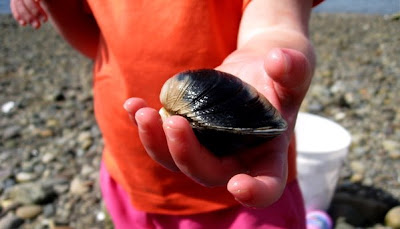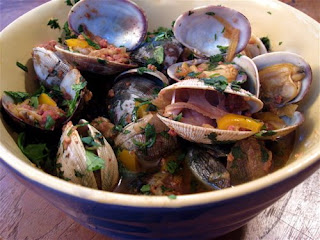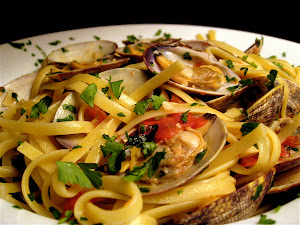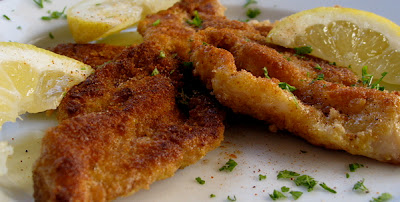The Ace Hardware in Ocean Shores, WA, had guns galore. You might say it was going great guns. I picked out a nice gray one, gun-metal gray, in fact, and then drove to the Porthole Pub for a bacon cheeseburger. An hour later the rain stopped and a few rays of sun snuck through the clouds—not that the weather would stop anyone today. By 2 p.m. the beach was already crowded. We drove out onto the hardpan sand like everyone else. Low tide was 3:58 p.m. I put my boots on, got the gun out, and wandered down among the people. The hooting and hollering had already begun. I took aim and fired.
Open season on razor clams!
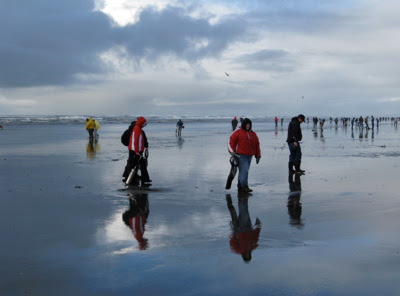
Like Noodling for flatheads in the Delta, running a sap line in New England, or dropping a baited hook through a hole in the ice in the Great White North, digging razor clams is a peculiar and time-honored expression of regional identity. Golden-hued and shaped like a straight-edged razor, the Pacific razor clam (Siliqua patula, for “open pod”) makes its home along the sandy, storm-tossed beaches of the Northwest, from Pismo, California, to the Aleutian Islands of Alaska, where they earn a living filtering plankton, particularly a species of diatom known as Attheya armatus.
Both humans and grizzly bears have a powerful taste for razor clams. Which brings us back to the clam gun. An ingenious device. Nothing more than a humble length of PVC or metal tube with a handle attached. Lacking a grizzly’s sharp claws and hump of back muscle, the human clam digger must strike a pose with his gun like a hard hat-wearing jackhammerer, then work his tube several inches down into the wet sand before closing a vent on the handle. With suction he can now pull up a core of sand—and, if he’s skilled, a razor clam secreted within.
Overkill, you say? 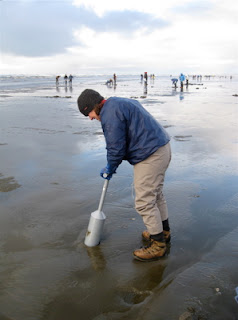 Razor clams are fast. Go ahead and laugh. Reports vary, but one researcher clocked a razor clam burying itself at a rate of an inch per second. At that pace, I refuse to entertain snide remarks about fair chase. These tubes are by far the weapons of choice for extracting the clams. Wherever you go you hear clammers referring to their “guns,” but in truth the term was originally coined to describe a small, angled shovel invented in the 1940s and used for the same purpose, and there are old-school clammers who will eagerly correct you if you call your tube a gun. But everyone does, and so did I.
Razor clams are fast. Go ahead and laugh. Reports vary, but one researcher clocked a razor clam burying itself at a rate of an inch per second. At that pace, I refuse to entertain snide remarks about fair chase. These tubes are by far the weapons of choice for extracting the clams. Wherever you go you hear clammers referring to their “guns,” but in truth the term was originally coined to describe a small, angled shovel invented in the 1940s and used for the same purpose, and there are old-school clammers who will eagerly correct you if you call your tube a gun. But everyone does, and so did I.
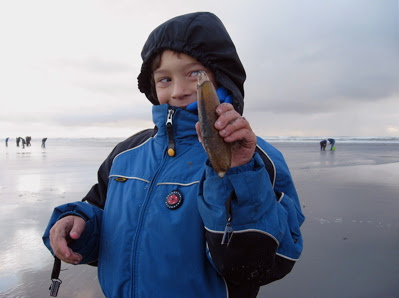
A limit of razor clams 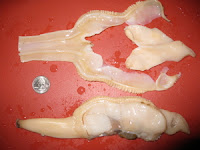 (15 per day in Washington state) may not seem like a lot on paper, but these clams can be monstrous, and one with a six-inch shell surely has more meat on it than a small quail. (The clams to the right, both shucked and one cleaned, are just average sized.)
(15 per day in Washington state) may not seem like a lot on paper, but these clams can be monstrous, and one with a six-inch shell surely has more meat on it than a small quail. (The clams to the right, both shucked and one cleaned, are just average sized.)
For both fish and clam chowders I hew closely to the classic New England recipe outlined by Mark Bittman in How to Cook Everything, which happens to be the same recipe used by my grandmother Mimi on the Cape, although unlike both Bittman and Mimi, I prefer using a generous roux of melted butter and flour to thicken the chowder. However, I’ll never go back to my earliest love of the whipped and creamy style so thick you can spread it on toast points, not since working in my youth at a Martha’s Vineyard restaurant famous for its chowder. Between us, that miraculous, float-a-cherry-on-top creaminess didn’t come from any particular technique or wizardry in the kitchen; it came from giant cans labeled “Chowder Base.”

Like this:
Like Loading...
 3 lbs littleneck clams
3 lbs littleneck clams


